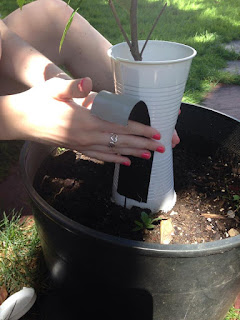I'm just going to get right to the point and say that a lot has happened
and I've been very neglectful of doing these blog posts.
Recently, my "sticks" have been doing quite well. Only two have leaves so I have basically resorted to assume that the remaining ones which have not grown leaves are dead. :-( Yet while I was partly unsuccessful in the "stick" department, my seedlings (all seven of them) have sprouted and have little leaves of their own. They're doing pretty well, but I need to move them out of the sun more. Some of their leaves are damaged and browning. 3: Other than that, they are pretty healthy and well-watered.
On another note, I have done some interactive research that was very successful. My mother and I ventured up to Syracuse for New York's 22nd ReLeaf Conference, the key topic of which was the American Chestnut tree.
I took plenty of notes, believe me, and I learned quite a bit about how SUNY ESF is producing blight resistant chestnut trees. Using transgenics, the scientists working on this endeavor (such Dr. William Powell and Dr. Charles Maynard) have been implanting an enzyme called oxalate into the genome of the American Chestnut tree. Oxalate is not a pesticide, it is a naturally occurring enzyme which we can find in foods we eat such as strawberries. (Talk about using GMOs for good...) It also is resistant to the chestnut blight; so by adding more of it to a tree they increase the tree's resistance to the blight. Fascinating, right?
After they implant the gene the must put the tree embryos through several stages: establish, multiply, root, and acclimatize.
1. Establish
The embryos are grown on petri dishes, essentially.
2. Multiply
Only 1 or 2 out of the thousands they produce actually thrive to create more resistant embryos which they can use!
3. Root
Some of the embryos, kept in a special medium, will develop roots and be planted.
4. Acclimatize
After rooting and being planted, the "seedlings" will be transferred to special areas in which they will be kept until the have developed enough to be placed in the field.
 |
| Here are the surviving acclimatized trees in a greenhouse |
After hearing several great talks, I went to go speak to a researcher at the school with whom I had been in contact with. Unfortunately she was not there when I went to look for her. Me being me, I was very hesitant to look else where, but my mother insisted that we at least check the greenhouses to see if there would be someone there who would be willing to help us. Nervous as I was, we did, and we actually met a woman who was very enthusiastic to help us out. Her name was Jaclyn Boylan, and (what luck!) she is the current caretaker of the planting grounds where the school is keeping their trees.
She led my mother and me there. I recall her saying that the whole plot was about 40 acres of land, all in which are 4 arboretums and research facilities, as well as her house and, of course, the chestnut trees! The plots of land on which they were planted were surrounded by these HUGE 8-feet tall fences, or "deer fences," as she called them. Within them the trees were planted neatly. There were tall ones, small ones, babies, and not.
It was amazing to see what my "stick" and seedlings may one day become.
 |
| Saplings with either stick supports or wrappings. |
Not to mention, I learned a bit on how to care for the trees as they grow.
I now know that my saplings should either get some form of support, either from a "cone" structure or a stick support so that they will grow upright.
 |
| These ones are about the size of my seedlings. :3 |
I also have learned that the seedlings should be kept out of direct sunlight.
Additional fencing may also be required to keep the smaller critters, such as bunnies or squirrels, from eating them.
Mrs Boylan told us that it wasn't long ago that a deer actually got into one of the areas... Yikes!
This was all extremely fascinating, BUT I think the highlight of the area was this:
That, my friends, is an adult American Chestnut tree. I'd say it was about 20-30ft tall and look...
IT HAD CHESTNUTS!!!
I got slightly too excited, haha. I was amazed at the mere sight of it and overwhelmed by the thought that one day I may help to grow something that large and magnificent.
There was a downside to this, though. As if it weren't obvious enough, the tree had a HUGE canker in its side from the blight. :C
It ate almost all the way through the tree to the opposite side, and looking up you could see that it was cutting off the nutrients to the branches above. Many of them were dead and the distinct rusty color of the bight was present on them.
 |
| The tree is sad too. (Can you see the ":-(" face?) |
Although that was pretty sad, the experience itself was very cool, and I am extremely grateful that I had that opportunity.
I hope to use the information I've learned in my presentations, and expand my outreach ... I have, after all, found some possible people to contact!
Anyways, I'll keep in touch!













